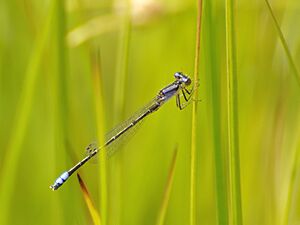Mauve bluet facts for kids
Quick facts for kids Mauve bluet |
|
|---|---|
 |
|
| Conservation status | |
| Scientific classification | |
| Genus: |
Proischnura
|
| Species: |
polychromatica
|
| Synonyms | |
|
|
The mauve bluet (scientific name: Proischnura polychromatica) is a tiny type of damselfly. It belongs to the family called Coenagrionidae. This special insect lives only in a small part of South Africa, in a region once known as the Cape Province.
Male mauve bluets have a shiny, purplish-pink (mauve) look on their dark bodies. Their middle section, called the thorax, is bronze-green with mauve stripes. Their tail, or abdomen, is light brown with a bronze-green stripe on top. Female mauve bluets are mostly light brown. These damselflies like to live near temporary pools in stream beds. They especially enjoy places with floating plants, like sedges. Sadly, the mauve bluet is now found in only one known spot. Its home is shrinking because of cattle and other changes. Because of these threats, the International Union for Conservation of Nature says it is an "endangered" species.
What Does the Mauve Bluet Look Like?
The adult mauve bluet is a very small damselfly. It has a special bluish-mauve or violet color on its mostly black body. Its face is a mix of mauve and black. The top of its head is a deep bronze-green. Its eyes are dark grey on top and light grey underneath.
Behind its eyes, it has wedge-shaped mauve spots. These spots are connected by a thin mauve line. The damselfly's middle body, the thorax, is dark bronze-green with pretty mauve stripes. Its wings are round, and they have reddish-brown spots called pterostigmata. The light brown abdomen (tail) has a bronze-green stripe. This stripe runs along the top from segments 1 to 7. The very tip of the abdomen (segments 8 and 9) is mauve. Female mauve bluets are light brown. They have a small dark blue spot on segment 9 of their abdomen.
Where Does the Mauve Bluet Live?
The mauve bluet is an endemic species. This means it is found only in South Africa. Specifically, it lives in a small area within the Western Cape Province. Its natural home is near rivers. It likes to visit pools that are drying up in stream and riverbeds. These pools usually have floating plants and lots of sedges.
Why Is the Mauve Bluet Endangered?
The IUCN has listed the mauve bluet as an endangered species. This means it is at high risk of disappearing forever. Scientists did not see this damselfly between 1963 and 2002. Now, it is known to exist in only two places. One of these places is in danger because cattle are moving into its habitat.
In general, the mauve bluet is struggling. Its natural home is being lost. Also, unwanted plants are growing too much in its habitat. These problems make it hard for the mauve bluet to survive.


